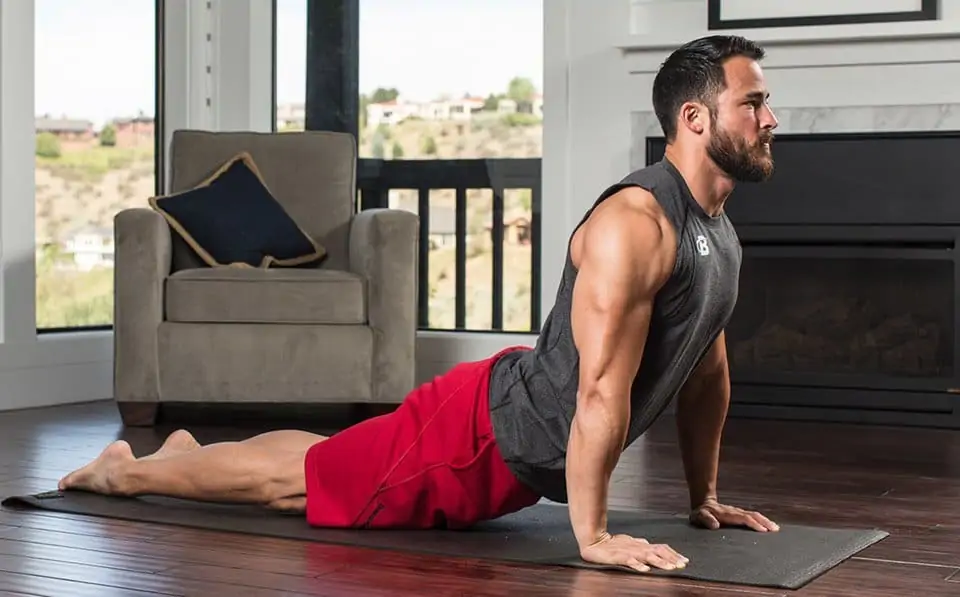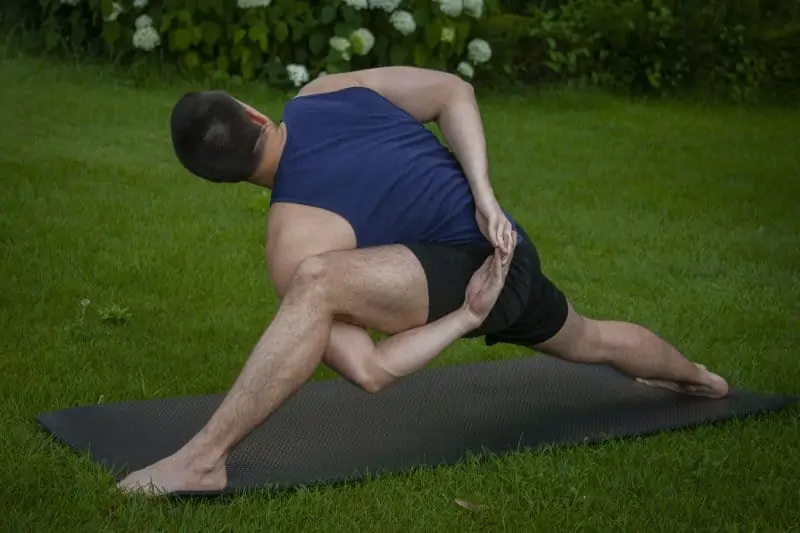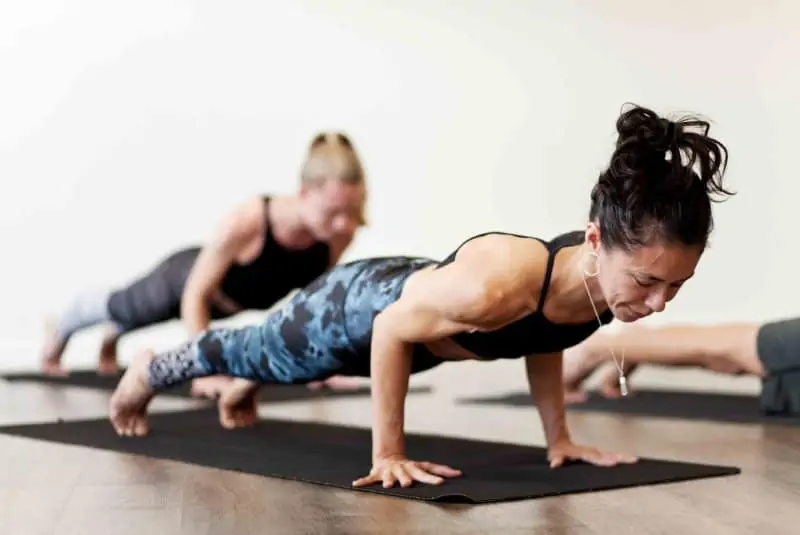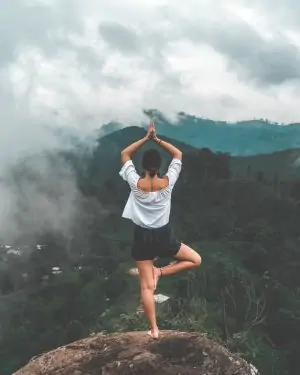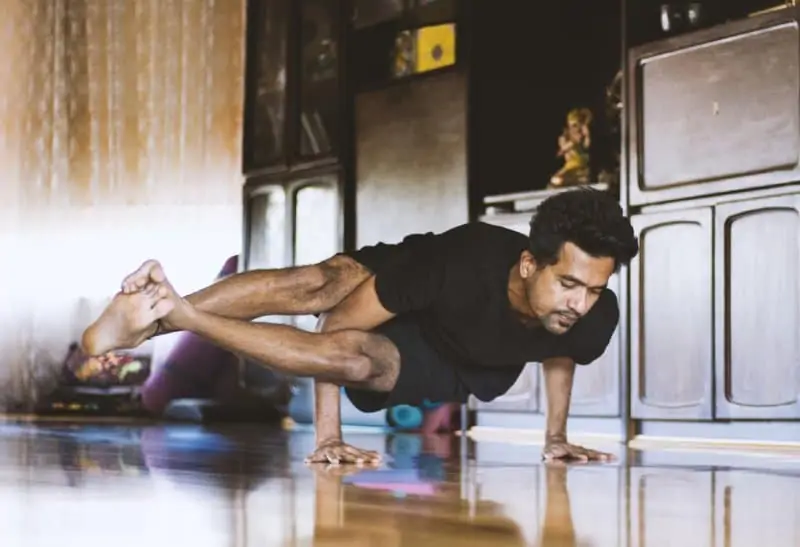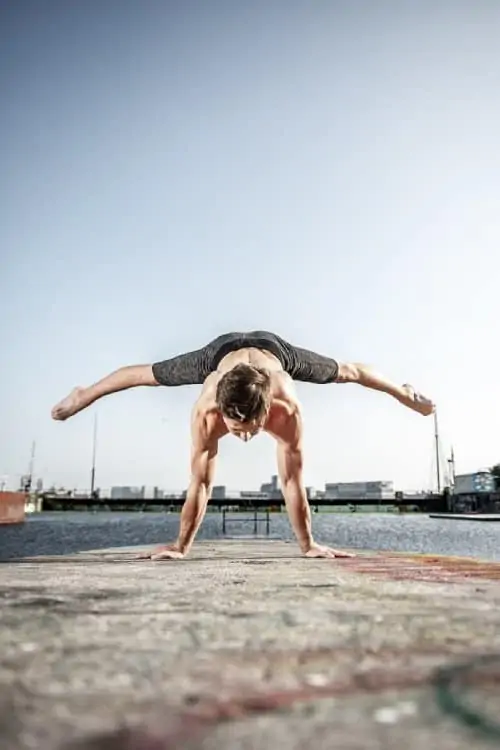Listen to this article:
Key Takeaway
Yoga offers a full-body workout that builds functional strength and lean muscle tone using bodyweight exercises, making it an effective alternative or complement to traditional weight training.
When contemplating strength training and muscular physiques, yoga for muscle building may not immediately spring to mind. Yet, the reality is that selecting specific poses and yoga class styles can effectively sculpt and tone various muscle groups, offering a holistic, full-body workout distinct from traditional gym machinery that targets isolated muscles.
If you think you can’t build muscle without lifting weights, you’re in for a zen surprise. A lean, toned, muscular physique can be achieved with just a yoga mat. Unlike standard weight training, yoga predominately uses your body weight to create functional strength while simultaneously decreasing stress, improving flexibility, and syncing breath with movement.
Professional athletes and weightlifters have repeated time and time that a regular yoga practice is one of the best complements to a gym-based workout routine. If you seek to enhance muscle strength, yoga for muscle building is key. Discover optimal postures and styles that complement or stand-alone, offering valuable support in your muscle-building journey.
Contents
Can You Build Muscle by Doing Yoga?
There’s no denying that muscle growth is not the central goal of yoga. Yoga is a much deeper journey of mind-body-spirit connection and all the benefits that come along with meditating, breathing, and challenging your mind.
But that doesn’t mean yoga can’t build muscle. Some of the strongest people I know are yogis! Yoga can help reduce your risk of injury, improve muscular endurance, and chisel muscles for that sleek, toned look that is both attractive and highly functional. That’s because yoga works whole groups of muscles in unison rather than isolating a single muscle. You are also twisting, arching, and moving those muscles in different directions depending on the yoga pose.
Body-weight yoga poses use an eccentric contraction, which stretches and lengthens the muscle fibers as tension is produced. This leads to greater flexibility and a more lean muscle tone, often seen among diehard yogis in the studio.
In contrast, weight training uses the opposite principle of concentric muscle contraction, which creates tension in the muscle as it shortens. This leads to a more bulging, compact muscle mass with less lengthening of the muscle fibers.
Both forms of muscle contraction are important and helpful when building muscle. But can yoga replace strength training? Absolutely! Or it can complement and enhance your gym workout routine.
Best Styles of Yoga for Muscle Building
If you want to build muscle on the mat, the yoga poses you choose to focus on may be a bit different from those used for deep relaxation or meditation. Power yoga, Ashtanga yoga, Bikram yoga, hot yoga, and Vinyasa are typically the yoga classes of choice for a fitness enthusiast.
A vigorous Hatha yoga practice can be used for muscle growth but will require longer hold times and more challenging poses to target the muscular strength you’re looking for. Yin yoga and restorative yoga are more focused on deep stretching and less likely to provide any strength-building benefits (though they offer lots of other benefits).
Regardless of which style you choose, here are six crucial yoga poses to practice for toning the entire body.
Top 6 Best Yoga Poses for Muscle Growth
These yoga asanas (yoga moves) will build strength in your whole body. They can be continuously modified with longer holds, more repetitions, or the addition of resistance bands.
Warrior Pose
Warrior I and Warrior II (Virabhadrasana I and II) are all about activating the lower body and stretching open the chest, as well as activating the thighs, calves, and hamstrings. The deeper you go into warrior poses, the more activation you will feel in the glutes and quads. You can add a bind and twist for maximum challenge. The warrior pose also tones the legs and improves blood circulation.
Triangle Pose
Trikonasana (triangle pose) can be held for 30–45 seconds and rev up the legs, arms, knees, spine, and core. It challenges your balance while strengthening the obliques and stimulating spinal nerves. Be sure to keep your body in a straight line as much as possible to avoid collapsing forward, which will make the pose less challenging.
Chaturanga
The classic yogi pushup (Chaturanga) is the four-limbed staff pose that builds upper body strength and challenges your core. It is a major part of sun salutations, challenging flows, and power yoga. You can hold a low chaturanga for as long as possible or challenge the back muscles with repeated yogi pushups.
Chair Pose
For another full-body activation, the chair pose (Utkatasana) is almost like a low squat with your knees together. It strengthens your thighs, quads, and ankles while challenging the core and arms as well. A deep chair pose can have you sweating and shaking fairly quickly after a minute or more of holding. You can also add a yoga block between your hands for maximum activation above the head.
Tree Pose
Tree pose (Vrikshasana) involves holding your full body weight on one leg and engaging the core for long-term balance. Other forms of tree pose include placing your foot on the inner knee, thigh, or hip, or practicing a squatting chair or tree variation for maximum muscle gains.
Arm Balances
All yoga inversions require building strength and balance simultaneously. Headstands, handstands, and Crow pose drastically improve blood circulation and core strength while balancing your whole body weight on your arms. These poses require full body activation and are not for the faint-hearted (or faint-headed). Be sure to practice arm balances with an experienced yoga instructor before trying them on your own.
How Does Yoga Build Muscle?
A strong yoga practice alone will build muscle without you thinking about it, but it helps to understand exactly what is happening on the mat to bring those toned results. So how exactly does yoga build muscle?
Progressive Overload
You may have heard of the principle of progressive overload in weightlifting. This means adding either more weight or more reps to progressively get stronger. As you lift heavier weights, your body builds more muscle to make it possible.
Yoga works through the same principle, except instead of adding more weight, it is focused on adding longer hold times and deeper variations of different poses. As you can imagine, your first Chaturanga (lowered push-up pose) in a yoga class is going to be a lot easier than the tenth one.
Progressive overload happens through pose repetition sequences and longer hold times. The key is to challenge yourself to go deeper and maintain endurance with every sequence and every yoga class. There are always advancements to be made that will make your muscles shake.
Mechanical Damage
While it may sound bad at first, mechanical damage to the muscles is crucial for muscular growth. As you add tension, lengthening, and contraction, microscopic tears occur in the muscles. The same thing happens when you lift weights. Through this physiological process, your muscles will increase in size as they heal, which is why rest days and stretching are so important.
Mechanical damage in yoga primarily happens through eccentric overload, which is when muscle hypertrophy or lengthening happens. This is often the downward motion of a weight-lifting exercise. In yoga, eccentric overload happens when you’re lowering or lifting your body to slow your descent or change the angle of your positioning.
Metabolic Stress
The “stress” part of metabolic stress might sound bad. I thought yoga was supposed to decrease stress. It is, but it also puts a positive form of metabolic stress on the musculoskeletal system. We typically call this “the burn” that you feel when holding a deep pose and your muscles start screaming at you.
The amount of metabolites that accumulate in your muscles during yoga ultimately determines how much metabolic stress they undergo and how quickly they will build strength. A vigorous Bikram class is going to accumulate a lot of metabolites, whereas a slow-paced yin yoga class will be more restorative and unlikely to build muscle.
Benefits of Building Muscle Through Yoga
There’s a reason that pro athletes like LeBron James, Kevin Durant, and Tom Brady regularly practice yoga as part of their fitness training regime. Yoga is the perfect complement to a muscle-building routine in sports or the gym.
Some studies have even found that sun salutations (a common Vinyasa yoga sequence) can improve endurance in gym workouts and even increase muscle strength for bench and shoulder press exercises.
The main benefits of muscle building through yoga include:
- Functional movements: Yoga poses incorporate dozens of different muscle groups into one position, resulting in holistic functional strengthening as opposed to a singular, isolated movement.
- Compound exercises: Yoga asanas are compound movements that bring balance and equilibrium to the body. They add a well-rounded challenge to your workouts.
- Low impact: Instead of straining your joints and tissues as heavyweights do, your yoga practice improves joint health and flexibility by improving circulation and building muscle in a low-impact way.
- Increased flexibility: Muscles need to lengthen to strengthen, and yoga does both simultaneously. More flexibility aids in functional fitness for better overall performance.
- Reduced risk of injury: Maintaining the health of muscle fascia and ligaments is equally as important as building strength. During yoga, tissues undergo lengthening and strengthening to improve mobility while preventing injury.
Closing Thoughts
Ultimately, yoga is a super effective tool for building muscle. Not to mention, you get all the mental health benefits—stress relief, flexibility, balance, and even spiritual wellness—that come along with your practice.
Bodybuilders may have major mass, but yogis have lean muscle tone, balance, and functional fitness from the mat. Since yoga is such a perfect complement to weight training, anyone seeking to optimize their strength and fitness can also enjoy the best of both worlds.
Namaste!


